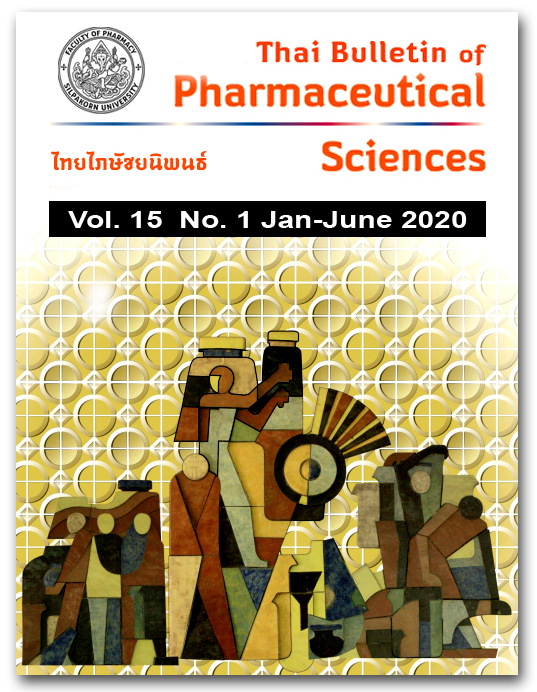COMPARATIVE STUDY BETWEEN RATIONAL DRUG USE (RDU) IN CROWN PRINCE HOSPITALS AND HOSPITALS UNDER THE ADMINISTRATION OF THE OFFICE OF THE PERMANENT SECRETARY FOR PUBLIC HEALTH (FOLLOWING THE IMPLEMENTATION OF A PROJECT AIMED AT IMPROVING RDU IN CROWN PRINCE HOSPITALS)
DOI:
https://doi.org/10.69598/tbps.15.1.109-127Keywords:
Rational drug use, key performance indicators, Crown Prince HospitalAbstract
This study aims to compare rational drug use (RDU) performance in Crown Prince Hospitals with that in hospitals under the Office of the Permanent Secretary, before and after the implementation of the Cooperative Project to Develop a Hospital Prototype for the Protection of Consumers Relating to Health Products in the Sub-District Health Promoting Level, that was implemented in Crown Prince Hospitals in fiscal year of 2018. The effects on RDU of the measures implemented under the project were investigated through the analysis of RDU performance data collected from 21 Crown Prince Hospitals and 79 hospitals under the Office of the Permanent Secretary. In addition, questionnaires were issued to 100 assigned pharmacists with specific responsibilities in RDU policy in the hospitals. Data was analyzed by descriptive statistics and inferential statistics. The results found that the Crown Prince Hospitals’ RDU performance were significantly better than the other hospitals’ in 2 out of 20 indicators; which were indicator-2 (p=0.038) and indicator-15 (p=0.048). No difference in these indicators was seen between the hospitals before the initiation of the project. From the questionnaires (77% response), a significant correlation was found between 1) the budget acquirement and the performance with indicator-2 (p=0.039), indicator-18 (p=0.042), and the past performance of the Tambon health promoting hospitals [indicator-19 and 20 (p=0.039)] 2) the executive policy with
indicator-2 (p=0.011), indicator-7 (p=0.045) and the past performance of the Tambon health promoting hospitals [indicator-19 and 20 (p=0.011)] 3) the monitoring of the executives with indicator-2 (p=0.020),
indicator-10 (p=0.041) and the past performance of the Tambon health promoting hospitals [indicator-19 and 20 (p=0.020)] and 4) the prescribers cooperation with indicator-6 (p<0.001), indicator-7 (p=0.002) and indicator-15 (p=0.040). It concludes that factors associated with hospital executives and their role in initiating hospital policy, were crucial in determining performance indicators in the rational use of antibiotics among hospitals and primary care units. Factors linked to the cooperation of prescribers also affected indicators relating to the rational use of antibiotics in hospital.
References
Phumart P, Phodha T, Thamlikitkul V, Riewpaiboon A, Prakongsai P, Limwattananon S. Health and economic impacts of antimicrobial resistant infections in Thailand: a preliminary study. J Health Syst Res. 2012;6(3):352-60. (in Thai)
The Sub-committee on Rational Drug Use Promotion. Rational drug use hospital manual. Bangkok: The Agricultural Co-operative Federation of Thailand Printing House; 2015. (in Thai)
Mininstry of Public Health (Thailand). Public Administration Division. Service plan: rational drug use. Nonthaburi: The Division; 2016. (in Thai)
Food and Drug Administration. National Drug Information (NDI). Situation of rational drug use, problems and related factors [Internet]. Nonthaburi: NDI; 2016 [cited 2018 Jun 9]. Available form: http://ndi.fda.moph.go.th/uploads/ policy_file/20170801152053.pdf (in Thai)
Cheawchanwattana A, Waleekhachonloet O, Rattanachotphanit T, Kitwitee P, Unlamarn R, Saisunantararom W, et al. Quality of out-patient prescribing: an analysis of 18 standard file datasets of hospitals. J Health Syst Res. 2012;6(2):167-75. (in Thai)
Puyati P, Kanjanarach T. Prevalence and pattern of antibacterial use in upper respiratory tract infections: a study in sub-district health promoting hospitals of Buayai contracted unit of Primary Care in Nakhon Ratchasima Province. Isan J Pharm Sci. 2015;11 Suppl.:253-60. (in Thai)
Pothidorkmai Y. A Model to monitor rational use of antibiotics in Chiang Yuen Hospital, Mahasarakham Province. J Health Sci. 2017;26 Suppl 1:S97-105. (in Thai)
Wilailuk S, Harntanyapong C. Study of antibiotics prescribing in Phayao’s sub-district health promoting hospitals. J Clin Pharm. 2017;23(1):13-20. (in Thai)
Food and Drug Administration. Bureau of Drug control. The cooperation project development of the hospital prototype for consumer health products protection in the sub-district health promoting hospitals during fiscal year 2018. Nonthaburi: The Bureau; 2017. (in Thai)
Sirijatuphat R, Choochan T, Siritongtaworn P, Sripojtham V, Thamlikitkul V. Implementation of antibiotic use guidelines for fresh traumatic wound at Siriraj Hospital. J Med Assoc Thai. 2015;98(3):245-52.
Chaiyasong C, Tiyapak P, Wongsriya A, Chaiyasong S. Types of wounds and patterns of antibiotic use in trauma patients in Mahasarakham Hospital. J Health Syst Res. 2019;13(1):116-24. (in Thai)
Sumpradit N, Anuwong K, Chongtrakul P, Khanabkaew K, Pumtong S. Outcomes of the antibiotics smart use project: a pilot study in Saraburi Province. J Health Sci. 2010;19(6):899-911. (in Thai)
Pumtong S, Duangchan P, Anuwong K, Sumpradit N. Lessons learnt from scaling up to sustainability of antibiotics smart use (ASU). J Health Syst Res. 2017;11(4):500-15. (in Thai)
National Drug System Development Announcement: National list of essential medicines B.E. 2562. Government Gazette. Number 136; Special section 95 D (2019 April 17) [Internet]. [cited 2019 Dec 3]. Available form: http://www.ratchakitcha.soc.go.th/DATA/PDF/2562/E/095/T_0008.PDF (in Thai)
Downloads
Published
How to Cite
Issue
Section
License
All articles published and information contained in this journal such as text, graphics, logos and images is copyrighted by and proprietary to the Thai Bulletin of Pharmaceutical Sciences, and may not be reproduced in whole or in part by persons, organizations, or corporations other than the Thai Bulletin of Pharmaceutical Sciences and the authors without prior written permission.



